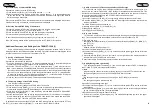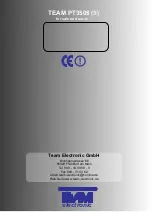
Upon reception of a station, that uses no or a different selective calling code, no signal is
audible. Only the LED Indicator ( 4 ) will emit a green light to indicate a busy channel.
Only one code combination of four short DTMF double tones to be recognized by the selec-
tive calling detection decision circuit can be programmed. There is only one selective calling
code available for all channels. After reception and verification of the code all requirements are
met to disable the mute control for the message to be audible. The message must be sent imme-
diately after the code.
Reception of the verified code and the message will be confirmed three seconds later by an
acoustic signal. The 1 – 5 symbols of the message are displayed from left to right in the display
part . In addition, the letter
C
is shown in the digit area . When pressing any key,
the message will disappear and the channel number will be displayed with a hyphen after the let-
ters
CH-
. If no message is received after verification of the code,
nOdAtA
( no data ) will be dis-
played in the display part . At the same time, the selective calling mute control is dis-
abled. This function is reactivated automatically after no signal has been received for a period of
time that can be set with the software T-UP2. To reactivate the mute control immediately, press
the monitor key [MONI] ( 7 ). To disable the mute control, press the PTT key [PTT] ( 6 ). When
the selective calling mute control is disabled, the LED blinks orange.
If the group calling function has been set up, one or more of the first three DTMF double
tones in the 4-tone code can be replaced by a special DTMF double tone, the group calling tone.
With the group calling function, numerous receivers can be called whose DTMF codes only vary
at the points where group calling tones are used. If a group calling tone has been used, the recei-
ver’s selective calling detection decision circuit will recognize a group call. The acoustic confir-
mation signal of a selective group call differs from a single selective call. The letters
GP
will be
displayed in the digit area .
With the software T-UP2, an automatic return call can be set up that will inform the trans-
mitter about the receipt of the message. This function is not available with group calling.
3) Remarks about the Mute Functions
All the above-mentioned procedures serve the purpose of filtering out unwanted messages. They
do not protect encoded messages from being listened to by other stations. All receivers that do
not have one of the mute control functions available will receive those encoded signals regard-
less.
4) Programming the Different Mute Control Functions
The mute control functions of the PT-3508 (3) can only be programmed via the software
T-UP2. Each channel can be set individually. It is even possible to assign different mute func-
tions to the receiving and transmitting part of a channel.
The mute control functions Code Squelch and Selective Calling can only be used in reception
mode, whereas CTCSS and DQT are available for reception and transmission. Code Squelch
and Selective Calling are not simultaneously available. You need to decide which one of the two
functions you want to use with your PT-3508 (3). CTCSS and DQT are both available and can
be concurrently used with one channel.
The list of the programmed channels can be displayed through the optional software T-UP2.
5) Monitor Key Functions
There are two available settings for the monitor key. The monitor key [MONI] ( 7 ) either dis-
ables the squelch and the mute control functions CTCSS, DQT and DTMF, or only the CTCSS-,
DQT- or DTMF-muting functions but not the squelch.
ENGLISH
ENGLISH
6) Transmitting with the different Mute Control Functions
The operation of the PT-3508 (3) will not change when using the mute control functions CTCSS
or DQT. When using the Code-Squelch or the Selective Calling functions, the DTMF code needs
to be entered prior to transmitting the message. The code is entered with the DTMF key pad
( 12 ). If required, the right column of letters ( A – D ) can be disabled with the software T-UP2.
Furthermore, it is possible to substitute the letter D with a pause, which length can be set.
7) Direct Transmission of DTMF Tones
a) Immediate Transmission
The following procedure to transmit any number of DTMF double tone characters directly, is
the only possible procedure unless your dealer programmed the PTT key [PTT] ( 6 ) in a special
way.
Push the PTT key [PTT] ( 6 ), while you enter the characters through the DTMF key pad
( 12 ). During this time, the LED emits red light and the channel selector is disabled. In the dis-
play, the bar indicator displays the signal strength and the actual channel is shown. The trans-
mitted DTMF tones are audible. While transmitting DTMF tones the microphone is deactivated.
b) Transmission of Temporarily Saved Data
With the software T-UP2 you can enable this second method, which allows sending a maxi-
mum of 16 characters. This
Save & Send
option allows you to store your message into a tem-
porary memory before you send it. The string of characters is entered via the DTMF key pad and
shown in the display. The last number always stays to the right. Since the display only has 6
digits, the rest will disappear from the display but still be sent. To send the stored message, push
the dial key [DIAL] ( 8 ). The LED emits red light, while the stored DTMF tones can be heard in
the speaker as they are transmitted. At the same time, the characters are displayed in the order
as they were entered. Once the transmission is completed, the actual channel shows in the dis-
play.
8) Storage of DTMF Strings of Characters
The PT-3508 (3) has nine memory banks available. Each memory bank can store a maxi-
mum of 16 characters. Some strings might already be programmed, that can easily be edited.
Procedure to store a string of characters:
1. Press the [DIAL] ( 8 ) key. The display will show
- - - - - - d
.
2. Push the number key
#
and enter the DTMF string of characters via the DTMF key pad ( 12 ).
3. Once the string is entered, press the [DIAL] ( 8 ) again and a hyphen next to the letter
d
will
indicate that the string can be saved into one of the nine available memory banks. (The
memory bank 0 always repeats the last transmitted DTMF string and cannot be used for long-
term storage.)
4. Select a bank by pressing any number between 1 and 9 on the DTMF key pad. The message
has now been saved to the selected memory bank and the actual channel is shown in the
display.
To clear a wrong entry press the monitor key [MONI] (7). The entire string has to be reentered.
9) Replay a Stored DTMF String Without Transmitting It
Procedure to playback a DTMF string without transmitting it:
1. Press the DTMF key [DIAL] ( 8 ). The display reads
- - - - - - d
.
2. Press the star key
*
and select one of the programmed memory banks 1 – 9. The memory
bank number is displayed next to the letter
d
, while the string is shown in the display. At the
same time the DTMF signals can be heard through the speaker.
Once completed, the display shows the actual channel.
26
27




























